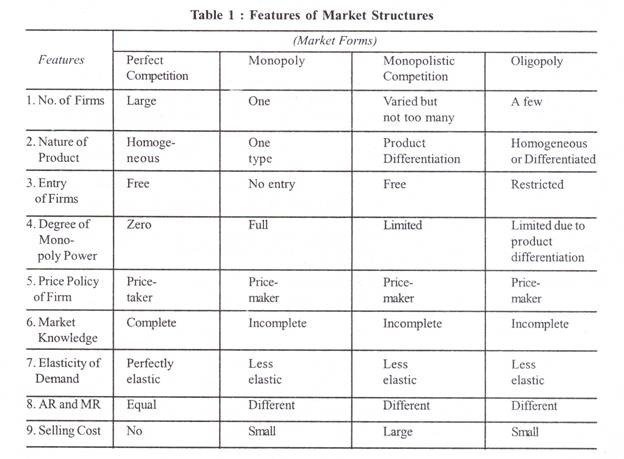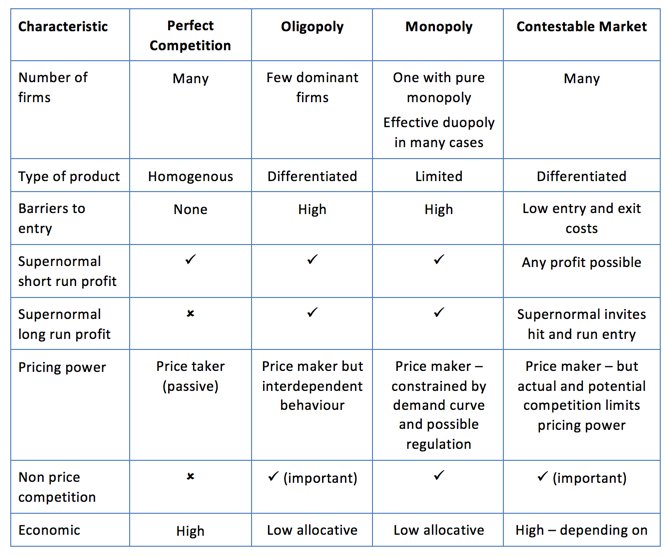Market structure refers to the organizational and competitive characteristics of a market that influence the behavior and performance of the firms operating within it. It defines how businesses interact with each other, how prices are determined, and how easily new firms can enter or exit the market.
Elements or Determinants of Market Structure:
- Number of Buyers and Sellers
The number of buyers and sellers in a market determines the degree of competition and price influence. In a perfectly competitive market, numerous sellers exist, none of which can individually influence price. In contrast, a monopoly has a single seller with complete price control. An oligopoly features a few dominant firms, often engaging in strategic pricing and product decisions. The greater the number of sellers, the more competitive the market becomes, leading to better choices and prices for consumers. On the buyer side, the presence of many buyers ensures demand diversity and minimizes buyer influence. If a few large buyers dominate (monopsony), they may exert significant control over prices and terms. Thus, the balance of buyers and sellers shapes the market’s competitive nature.
- Nature of the Product
The type of product offered—whether homogeneous or differentiated—significantly influences market structure. In perfect competition, products are identical (e.g., wheat, salt), leaving firms with no control over pricing. In monopolistic competition, products are similar but differentiated by branding, quality, or features (e.g., clothing brands), allowing some pricing power. In oligopoly, products may be either homogeneous (e.g., cement) or differentiated (e.g., automobiles), and product features become strategic tools for competition. In a monopoly, the firm offers a unique product with no close substitutes, granting it full pricing authority. Product nature affects customer loyalty, elasticity of demand, and marketing strategies. The greater the product differentiation, the more power a firm has to set prices and influence consumer choices.
- Degree of Price Control
Price control refers to the extent to which a firm can influence the price of its product. In perfect competition, firms are price takers—they accept market-determined prices due to intense competition and identical products. In monopolistic competition, firms have limited pricing power due to brand loyalty and differentiation. In oligopolies, firms have considerable price control, but often follow price leadership or engage in collusive pricing to avoid price wars. A monopolist, on the other hand, is a price maker, setting prices to maximize profits, although constrained by consumer demand and potential regulation. The degree of price control depends on factors like product uniqueness, market entry barriers, and consumer sensitivity. Understanding price control helps assess market power and the potential for consumer exploitation or competitive pricing.
- Entry and Exit Barriers
Ease of market entry and exit is a key element of market structure, affecting the level of competition and innovation. In perfect competition, there are no barriers, allowing new firms to enter freely and keep profits in check. In monopolistic competition, entry is relatively easy, though branding may pose minor challenges. In oligopoly, high entry barriers such as heavy capital investment, economies of scale, and control over distribution prevent new competitors from entering. In a monopoly, barriers are the highest, often due to patents, government licenses, or ownership of key resources. These barriers protect existing firms from competition, allowing them to maintain profits and influence. Lower entry and exit barriers promote market dynamism, while higher barriers can lead to reduced competition, higher prices, and consumer disadvantage.
Factors influencing Market Structure:
- Number of Firms in the Market
The number of firms determines the level of competition in a market. A large number of firms typically results in a competitive structure like perfect or monopolistic competition, where no single firm dominates. Fewer firms may lead to oligopoly or monopoly, where market power is concentrated. The higher the number of firms, the less control each has over pricing and supply. This factor directly affects how freely new businesses can enter the market, influence prices, and affect consumer choices, shaping the overall structure and nature of business rivalry.
- Nature of the Product
The similarity or differentiation of products significantly impacts market structure. Homogeneous products, such as grains or steel, lead to perfect competition, where firms compete solely on price. Differentiated products, like branded clothing or electronics, result in monopolistic competition or oligopoly, where firms gain some price control through branding and features. A unique product with no substitutes, as seen in a monopoly, gives complete pricing power to the firm. The more distinct the product, the higher the potential for firms to establish loyal customer bases and exercise market influence.
- Control Over Prices
The degree of control firms have over pricing determines their influence in the market. In perfect competition, firms are price takers—they cannot alter prices due to intense rivalry. In monopoly, a firm is a price maker, controlling prices due to a lack of substitutes. Oligopolistic firms have considerable price-setting power but often avoid price wars through collusion or tacit agreements. Price control is shaped by product uniqueness, brand value, and the availability of alternatives. More price control indicates less competition and a more concentrated market structure.
- Barriers to Entry and Exit
Barriers affect how easily new firms can enter or leave a market. Low barriers promote competition, as seen in perfect and monopolistic competition. High barriers, like legal restrictions, high startup costs, and access to technology, protect established firms in oligopolies and monopolies, reducing competition. These barriers determine market dynamics, profitability, and innovation levels. The ease or difficulty of entering the market shapes the competitive intensity, and hence, the overall market structure. Exit barriers, such as long-term contracts or sunk costs, also influence firms’ decisions and market fluidity.
- Economies of Scale
When firms grow large enough to lower average costs through mass production, they experience economies of scale. This factor influences market structure by favoring oligopolies and monopolies, where large firms dominate due to cost advantages. Smaller firms find it difficult to compete, leading to a concentrated market. The presence of economies of scale raises entry barriers, discouraging new entrants and reducing competition. Industries like telecom, aviation, and energy often display this trait. This factor strengthens the position of existing firms and shapes the strategic behavior in the industry.
- Level of Innovation and Technology
High levels of innovation and advanced technology can significantly affect market structure. In tech-driven industries, early adopters often gain a temporary monopoly due to patents, proprietary processes, or first-mover advantages. Rapid innovation can reduce entry barriers if technology is widely accessible, but may also create new barriers when it involves complex, capital-intensive processes. Innovation leads to product differentiation, changing competitive dynamics and often shifting markets from monopolistic to oligopolistic forms. It influences firm growth, pricing strategies, and the overall shape of market competition.
- Government Policies and Regulations
Government intervention through licensing, tariffs, price controls, and antitrust laws significantly influences market structure. Policies that encourage free trade and deregulation promote competition, while those granting monopoly rights or subsidies can limit it. Regulatory frameworks may either lower or raise entry barriers, depending on their objectives. For instance, strict patent laws can create monopolies, while competition laws may break up large firms. These rules impact pricing, market access, and competitive fairness, playing a crucial role in shaping the structure and efficiency of different markets.
The features of market structures are shown in Table 1.

Important features of market structure:
- Number and Size of Buyers and Sellers
The number and relative size of buyers and sellers directly influence the nature of competition in a market. In perfect competition, there are many small buyers and sellers, so no single entity can influence the price. In contrast, monopoly features one large seller dominating the entire market. Oligopoly has few large sellers, while monopolistic competition has many sellers offering differentiated products. The balance of power between buyers and sellers determines price-setting behavior, market entry, and overall market dynamics.
- Nature of the Product
Products can be homogeneous (identical) or differentiated. Homogeneous goods (e.g., wheat, sugar) are typical of perfect competition, where consumers have no preference between suppliers. Differentiated products (e.g., smartphones, clothing) are associated with monopolistic competition or oligopoly, where branding and features give firms some pricing power. In monopoly, the product is unique with no close substitutes. The product’s nature shapes consumer choice, pricing strategy, and firm competitiveness, making it a key feature in defining the structure of a market.
- Degree of Price Control
Price control refers to how much influence firms have over the price of their products. In perfect competition, firms are price takers, accepting market-determined prices. In contrast, monopolies are price makers, having full control due to lack of substitutes. Oligopolies have partial control and often avoid price wars through mutual understanding. Monopolistic competitors can influence prices slightly due to product differentiation. The ability to control prices affects profitability, strategic planning, and the level of consumer surplus in different market structures.
- Entry and Exit Conditions
The ease with which firms can enter or exit the market impacts the level of competition. Free entry and exit, seen in perfect and monopolistic competition, keeps profits normal in the long run. High entry barriers in monopoly and oligopoly markets, such as large capital requirements, patents, and government regulations, protect existing firms from new competitors. These conditions influence firm behavior, investment decisions, and the long-term structure of the industry. Exit barriers also matter, including sunk costs and contractual obligations.
- Flow of Information
Market transparency, or the availability of information, significantly impacts decision-making. In perfect competition, information is perfect and freely available to all participants, ensuring rational decisions and uniform prices. In monopoly, oligopoly, or monopolistic competition, information may be asymmetric—some firms have better access to market data, customer preferences, or production techniques. Information asymmetry leads to inefficiencies, mispricing, and poor resource allocation. The better the information flow, the more efficient and competitive the market structure becomes.
- Interdependence Among Firms
In oligopoly, firms are highly interdependent; the actions of one firm significantly impact others. For example, a price cut by one may trigger retaliatory pricing. In monopoly and perfect competition, interdependence is minimal—monopolies face no rivals, and perfect competitors are too small to affect market outcomes. Monopolistic competition lies in between, with firms competing based on product features. This interdependence influences strategic behavior, including pricing, advertising, and innovation, and it makes game theory and collusion relevant in oligopolistic settings.
- Government Regulation and Legal Framework
Government rules and policies shape the nature and behavior of market structures. Antitrust laws, price controls, trade regulations, and licensing influence how freely firms can operate, compete, or dominate. Monopolies may be state-sanctioned, while competitive markets are supported by policies promoting transparency and consumer rights. Legal restrictions may also create barriers to entry, affecting the long-term dynamics of the industry. In regulated markets, government action balances business interests with consumer welfare, playing a crucial role in defining market behavior and structure.
- Profit Margins and Cost Efficiency
The structure of a market significantly impacts potential profit margins and cost structures. Perfect competition leads to minimal profit margins due to intense competition and price pressure. In contrast, monopolies enjoy higher profit margins due to price-setting power and absence of competition. Oligopolistic firms also enjoy significant profits through collusion or differentiated services. Monopolistic competitors rely on brand value to maintain margins. Additionally, cost efficiency varies—larger firms may benefit from economies of scale, leading to lower average costs and higher profitability in certain structures.

1. Perfect Competition